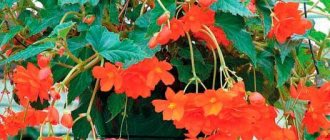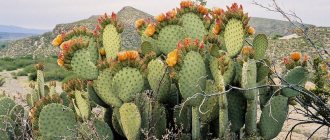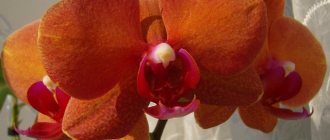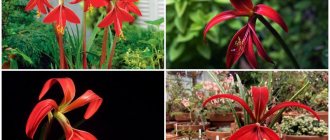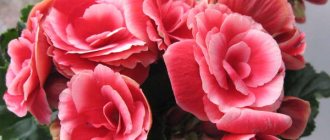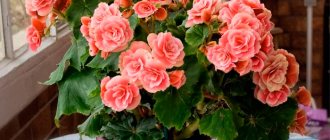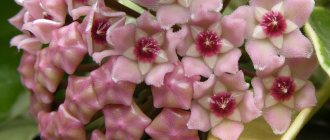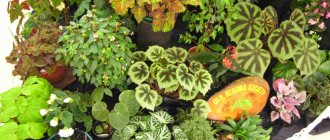In today's episode:
Good afternoon, dear guests of my blog.
Finally, I got around to this article, in which I will talk about my experience in rooting the capricious Elatior Borias.
And although at first I did not plan to somehow make my experiment public, it turned out to be quite interesting, and the results surprised me.
Therefore, I decided to show what I did, perhaps my experience will be useful to someone.
My fascination with these begonias began when I accidentally came across a photo of the Elatior Borias begonia on the Internet.
I was simply amazed by her beauty. And as an experienced maniac gardener, I scoured all the collectors’ forums, pages on social networks, Avito, online stores for the sale of this plant in my city.
I was interested in already domesticated cuttings. I had read about how difficult it is for Dutch store-bought begonias to take root, and I didn’t want to mess with them.
Unfortunately, I was unable to purchase a homemade cutting. And the stars coincided so well that when I found myself in the shopping center on completely different, non-flower matters, I saw him...
It stood on the counter of the flower department and looked stunning!
Mentally, I immediately christened him Boriska and promised him that today he would be standing at my house.
I had to slow down my husband, who was briskly dragging me past, into the grocery department, and tell him that I wanted this Boris.
My husband almost slipped, I was drooling so much at the sight of this masterpiece of nature and selection, followed the direction of my gaze, and understood me correctly.
The price tag of 500 rubles caused a slight sadness in his eyes, and he probably thought that I was a witch, because I always manage to find a place for a new flower on our windowsills, where you can’t even insert a finger between the pots.
But my husband has moments of enlightenment when it is extremely difficult for him to refuse me. And a couple of minutes later Borias was in my tenacious hands and was on his way to his new place of residence.
About the plant
The plant is a perennial shrub, of a hybrid type. The maximum height reaches no more than 40cm. The stem is strong and fleshy. Flowers are usually up to 8 cm in diameter, collected in inflorescences. They are placed on long peduncles.
The color of the petals varies, depending on the variety. The texture of the inflorescences is terry and smooth. The type of flowers resembles a little inflorescence of roses and peonies. The leaves have an asymmetrical, heart-shaped shape.
Their color is dark green with a glossy sheen; underneath they are light green. The main feature of this species is flowering in the cold season , for this quality the plant is given the second name “winter”.
Description of the flower
A hybrid species of the Begoniaceae family, obtained by crossing tuberous and Socotrans begonias. The height of the bush reaches 40 cm and is characterized by fleshy stems and glossy leaves in the shape of an asymmetrical heart with jagged edges of a characteristic color (the top is glossy green, the bottom is matte salad green with pronounced veins).
During flowering, the plant is covered with bright inflorescences of rich, rich shades on thin peduncles growing from the axils of the leaves. The diameter of the flower is about 5 cm. The flowering period of Elatior begonia is from the beginning of summer to the end of winter, which is why it received its second name - winter begonia. You can read about other types of flowering begonias and the features of their cultivation in a separate article.
Reference! This hybrid was bred in 1883 by the English gardener Z. Veitch.
Breeding methods
Novice amateur flower growers are afraid to breed the winter beauty on their own, so they often purchase a ready-made flower in stores.
In fact, there is nothing difficult in propagating a plant; even a non-professional can do it. Begonia is bred in the following ways:
- planting seeds;
- rooting cuttings;
- a leaf or part of a leaf;
- division of the mother bush.
How to root with cuttings?
Even in comfortable conditions, after 4-5 years the plant should be rejuvenated . The cutting method is the least troublesome, fast and effective. The survival rate of begonia seedlings is quite high. The method also allows you to obtain samples identical to the maternal one.
The vegetative method of propagation of begonias is divided into the following stages:
- preparation of cuttings;
- processing of planting material;
- rooting;
- planting a young plant in the ground.
Important! It is recommended to carry out the cutting process in April and no later. Summer cuttings are short, too squat, they bloom quickly, not giving the plant the opportunity to grow.
Preparation
The upper sections of the stem, healthy and strong, 8-10 cm long, are used as cuttings . They must have at least 3 buds. The leaves must be removed, leaving no more than two, so as not to take away the strength of the sprout.
The operation is performed exclusively with a sharp knife, diagonally, so the interaction of the plant with the environment will be more effective. The sections should be treated with preparations for stimulating root formation “Kornevin”, “Zircon”.
Instructions
To germinate, the cuttings are placed in water or placed in a substrate.
When rooting in water, it is recommended to choose containers made of transparent material with a small diameter . This is done so that the process not only grows, but also gains strength. The water must be clean without impurities and salts. An activated carbon tablet should be added to the container with the cutting as a precaution against the development of fungal infections.
For about 30 days, the sprout is placed in a bright place, with a temperature of +22-24°C. Don’t forget about humidity – at least 60%. Transparent material allows you to immediately see the hatching roots. After a month, the root system will be formed.
It is better to choose coconut shavings, sawdust, and vermiculite as a substrate. These materials have antibacterial properties. The cuttings are soaked in water and then dipped in a special solution for rapid development of the root system. Select a pot to suit the size of the cutting and bury it at an angle into the moistened substrate by 2-3 cm.
Make sure that the sheet does not come into contact with the ground.
Then the container is covered with transparent material to create a greenhouse effect. Optimum temperature +22-24°C. It is necessary to regularly moisten the substrate, preventing it from drying out. And also ventilate so that excess moisture does not accumulate. The rooting process lasts from 4 to 6 weeks.
Planting in the soil
After a month and a half, you should transplant the sprout into fertile, loose soil (also read about the nuances of replanting a flower here).
For replanting, select specially prepared soil for begonias with a neutral pH. Drainage is placed at the bottom of the flowerpot. You should lower the plant into the ground carefully; the roots are very fragile so as not to break it. Then the begonia should be watered with settled warm water. At this stage it is important:
- Feed the young plant with mineral fertilizers with a high nitrogen content for active growth;
- harden seedlings;
- provide 16 hours of daylight.
After another month, it is important to begin to stimulate the development of peduncles. The plant will receive light until 9 o'clock a day; the rest of the time the sprouts are covered with black film. This regime is maintained for 10-14 days, then the previous conditions are restored. After 2-3 months, the young plant will begin to bloom.
Seeds
Growing Elatior begonia using seeds is used extremely rarely, due to its hybrid origin. Collecting seed material is difficult. The only variety that reproduces in this way is Charisma. They begin planting seeds in late February, the deadline is mid-March, then the first flowers will appear at the beginning of summer.
Seedling boxes are chosen as containers. It is better to buy ready-made, non-acidic soil. The bottom of the flowerpot is covered with a mandatory drainage layer. The day before planting the seeds, the soil needs to be watered. The soil temperature should be between +26-28°C. The seeds are planted evenly in the ground and covered with glass or other translucent material.
Seedling boxes are placed in a room with a temperature of +22-24°C and good lighting. The time of emergence of seedlings varies from 10 to 21 days. Seedlings can be planted with 2-3 leaves. also important to feed young shoots with mineral fertilizers and pinch them as they grow.
Important. If you plan to decorate outdoor space with begonia in the future, then 30 days before, the plant is hardened.
How to root begonia elatior?
Among the many types of domestic plants and flowers growing on the windowsills and balconies of peaceful inhabitants, begonia is one of the most popular representatives of domesticated flora. The fact is that the homeland of begonia is the American, Asian and African tropics and subtropics. And the name of the plant was given by the governor of Saint-Domingue (which is in the west of the island of Haiti) Michel Begon, who simply adored flowers. Nowadays, about a thousand different species and varieties of begoniaceae are cultivated. Begonia was domesticated for its beauty and brightness. Before we talk about begonia propagation, let's take a closer look at this plant.
Groups and species Among begoniaceae, it is customary to distinguish several groups: tuberous, leaf and bush begonia. Plants of the first group reproduce using tubers growing underground. In leaf begonia, instead of tubers, there is a thickened rhizome underground, which is involved in the propagation of the plant. Begonias also differ by type: shrubby, subshrub, herbaceous begonias. Hybrid varieties of this plant grow in apartments and country flower beds. Among indoor begonias, there are only two types of this plant - decorative flowering and leafy begonia. Some types of decorative flowering begonia have dying foliage, and some have year-round (non-dropping) foliage. In the case of foliage dying, another generation of flowers in the plant comes from its tubers (in the case of bush begonias, the plant goes into a state of deep dormancy). Although the evergreen begonia does not shed its foliage, its flowers are not so beautiful.
As for the beauty of the appearance of begonias, the most striking in this regard are tuberous begonias. Tuberous begonia flowers can be double or not, and the color palette ranges from white (cream) to bright red. The size of begonia flowers varies between 5-15 cm.
www.tonature.info
Possible problems
- The cut of the cutting began to rot in the water. The plant may have become infected with a fungal infection. It is necessary to remove the cutting from the water, cut off the rotten part, place it in a container with fresh water, into which ½ tablet of activated carbon is added.
- Elatior begonia seeds do not hatch for a long time . Perhaps the reason for this is dry soil, or low room temperature. Measures should be taken: moisten the soil and increase the room temperature to +22-24°C.
- The seedlings stretch out, becoming long and thin. The plants clearly do not have enough sunlight. If possible, it is worth moving containers with seedlings closer to the light source.
- Slow growth. Perhaps the young plant does not have enough nutrients in the soil, so it should be fed with fertilizers.
Bloom
In order for elatior to bloom long and profusely, an artificial “short day” - the duration of daylight hours is reduced to 9 hours , covering the plant with black plastic film .
This procedure, carried out over two weeks , promotes the formation of buds.
To prevent the stems from stretching during this time, use growth inhibitors or pinch the shoots.
Then the daylight hours are increased again to 16 hours - additional lighting may be needed.
As a result, begonia blooms in about 2 months.
It should also be noted that a plant that has once bloomed “in full” - long, abundantly and for a long time - takes a long time to recover and is unlikely to bloom again with the same intensity.
Further care
The tropical beauty requires special conditions, it is often subject to stress, and the development process directly depends on the surrounding parameters. To get good results when growing begonias, you should pay attention to the following nuances:
The optimal temperature and humidity conditions in the room should be at +22-26°C, humidity 70%.- Begonia Elatior prefers diffused sunlight.
- Moderate moisture, do not flood the plant with water. You need to water again when the top layer of soil dries well. Do not spray the plant under any circumstances, otherwise this may lead to the development of fungal diseases.
- During the flowering period, it is important to feed the flower with fertilizers high in potassium and phosphorus. During the active growth phase, fertilize with nitrogen minerals, but in moderation.
- In winter, the air temperature should be maintained at no lower than +18°C, with minimal watering.
- As the plant grows, it should be pinched so that the bush has a neat shape and compact size. Remove the top shoots from the crowns. Removing the lower leaves helps to ventilate the root zone of the flower.
- As necessary, you should pick off dried flowers, loosen the soil, spray, remove dust from the foliage, and inspect the plant for pests.
Find out more details about how to care for Elatior begonias so that they will delight you with their flowering even in winter.
Begonia is represented by a wide variety of species. On our website we have prepared a number of articles with detailed descriptions and useful tips on planting and caring for some of the flower varieties, such as: Bolivian, Collared, Griffith, Diadema, Smaragdovaya, Sizolistnaya, Tiger, Hogweed, Metallic.
Propagating and growing Elatior begonia at home is not so difficult. The main thing is to stick to the basic rules at first, and with experience everything will go like clockwork. And the most beautiful, charming flowers will bloom in your house.
Reproduction
The flower is propagated vegetatively - by cuttings, and some varieties - also by seeds .
Stem cuttings
Spring and summer cuttings
are used , which have a pair of leaves and two growth buds. The sections are dried.
You can pre-root the cuttings in water, treat the lower cuts with rooting stimulants, or immediately plant them in regular soil with additional sand.
The planting is covered with plastic film, kept warm (+ 22-25ºС ), ventilated and moistened.
After the formation of the root system and the formation of new shoots (within about a month ), the cuttings are planted in separate containers with a regular soil mixture.
Leaf cuttings
Take a large, well-formed sheet, spread it on a hard, smooth surface (on glass) and with a sharp blade divide it from the center into segments so that each part has one or two vascular veins .
The resulting parts are laid out on the surface of the soil (the lower ends can be slightly buried), moistened, covered with plastic film, moistened, ventilated and kept at a temperature of 20-22 degrees.
Within a month, the begonia will be reborn even with such “dismemberment” and will form small new leaves in the places where the veins are cut .
Seeds
Some elatior varieties, for example, the group of F1 hybrids, can be propagated by seeds throughout the year (additional lighting will be required in autumn and winter) .
Small seeds are placed on the surface of the soil mixture, sprayed with water, covered with plastic film, ventilated, kept at a temperature of 25-27ºC and good lighting .
Shoots appear in 2-3 weeks.
After the formation of two or three true leaves, the seedlings carefully dive, reduce the temperature to 18-20ºC and limit watering .
As they grow, they are seated.
To further stimulate the formation of buds on young plants, use the “black bag” method, described in the “Flowering” section.
Reviews
Apparently, flower growers really like Elatior begonia. Spectacular culture. Bright, juicy and odorless (a plus for allergy sufferers). An excellent pot and balcony plant, requiring minimal care, but so decorative that one can make a balcony noticeable. Opinions differ greatly about unpretentiousness: some consider it completely unpretentious, others call it a capricious plant, but do not give up trying to make friends with it.
Particularly successful flower growers manage to prolong the flowering of an old plant for up to two years by pruning the bush in time (and using cuttings to produce new plants). Some note that their plants bloom even in a draft or on a northern window, and require no care at all, while still being covered with flowers. Problems described include: rapid death of the plant, flowers falling off immediately after purchase, problems with propagation by leaves or cuttings.
When to replant after purchase
Immediately after purchase, it is important to avoid mistakes that could even lead to the death of the plant. Begonia Elatior can be replanted after purchase only when it has completely bloomed. An emergency transplant is possible if the flower is flooded with water or the soil in the pot is of questionable quality.
In all other cases, you should think about replanting after flowering and new leaves grow. Signs of the need for replanting can also be considered roots that are cramped in the pot and begin to crawl out.
The new pot should not be much larger than the old one. It is best to buy a special soil mixture for replanting begonias in advance at a specialized store or prepare it at home. To do this, you need leaf soil (half the volume), peat and humus. You need to add a layer of sand to the bottom of the pot.
Important! If there is no special mixture for begonias, you can use soil for violets or any universal soil that contains peat.
Begonia Elatior is carefully transferred into a new pot along with a lump of earth. It is important not to damage the roots of the plant, otherwise they may begin to rot.
Diseases and pests
Maintenance errors, primarily stagnation or lack of moisture in the soil, weaken the plant and provoke its defeat by powdery mildew . In this case, you need to optimize watering and treat the begonia with fungicides.
The combination of high humidity and low temperature leads to the development of root or leaf rot . If the process has just begun, you should urgently optimize the temperature and humidity conditions and remove damaged parts. In case of severe damage, you will have to root cuttings cut from healthy shoots and keep them in appropriate conditions, and get rid of the rest of the plant.
Begonia can be attacked by spider mites, aphids, scale insects, thrips and mealybugs . As a first measure, insects are removed using a cotton swab dipped in alcohol or treated with a soap solution. The most effective pest control is systemic insecticides.
Begonia elatior is a beautiful hybrid of two geographically distant “parents” - it is exclusively decorative during the period of abundant long flowering, which also extends into winter. At the end of this flower “fireworks”, having neither tuberous nor bulbous “reserve of strength”, the plant most often takes a long time to come to its senses.
